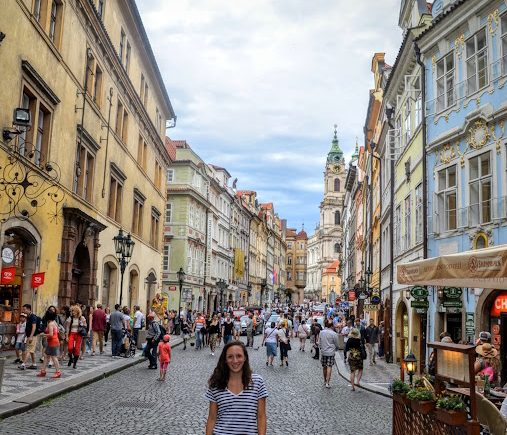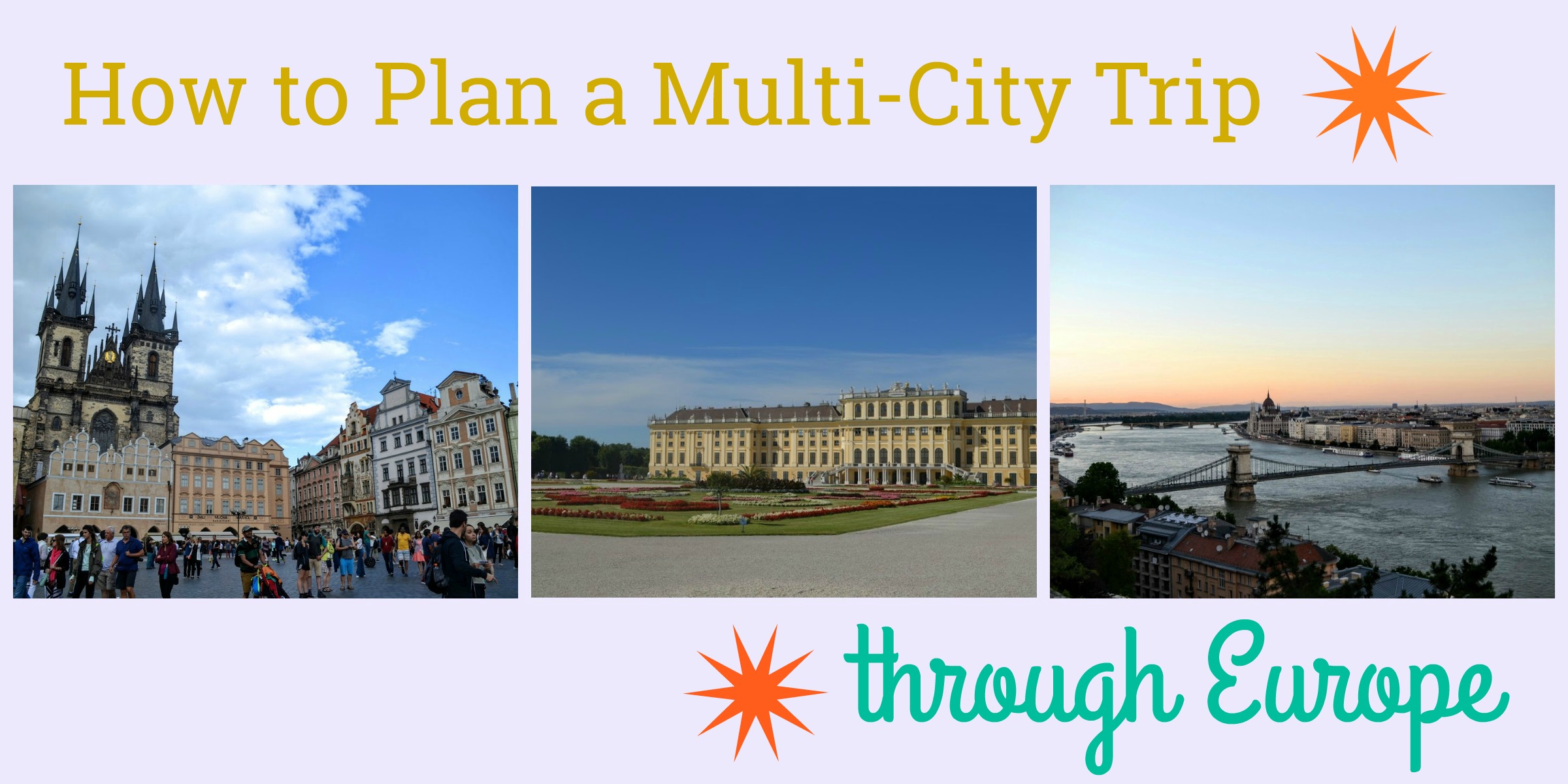Planning any Multi-City European trip can be overwhelming- so much to organize! Flights, hotels, trains, buses, AirBnb, rent a car?, restaurants, hitting the major sites, AND MORE. But that’s one ball game. Planning a multi-city trip is a whooooole other beast. It can be totally intimidating, and before doing it myself last summer (to visit Prague, Budapest and Vienna), I thought it was a crazy mess, but I am doing it again this summer (to visit Milan, Venice, Florence, Cinque Terre, AND MORE), and I can tell you that it isn’t as bad as you think. Of course, there can always be some unforeseen hiccups, but with some quality planning, your trip will go quite smoothly.
Step 1 // Have a rough estimate for the number of days you plan to be away
Take into consideration the distance between cities (as travel time takes a big chunk of your day), what you plan to see, if you plan to do day trips, etc. Don’t be too ambitious with this- sometimes a more relaxed trip is good, and sometimes you want to pack in 5 cities in 10 days. You decide.
- Something to consider: do you like museums? Europe has a lot of museums and each one takes a few hours to explore. Personally, I am not a museum person. I usually enjoy the MUST SEE museums, but I don’t need to see every single museum there is. Other people do enjoy museums and should build in time for this.
- Other things to consider: Do you like to be go-go-go all day, or do you prefer a slower start and some downtime?
- TIP: Use Google to estimate how much time people say is good to spend in various cities. TripAdvisor and Fodor’s will become your best friend. Fodor’s actually has pre-created itineraries you can download and use as you please. Take advantage of the advice other people give!! For Prague/Vienna/Budapest (I will now refer to this as PVB), we were away 10 days- 3 in P, 2 in V, 3.5 in B. For Italy, we are planning on 11 full days.
Step 2 // Decide which cities you want to hit and then make a rough outline
You should include number of days you will be in each city and when you will travel to the next (ie: train in the late afternoon to get to the next city at night, or maybe you prefer to take the train early the next morning?). I personally prefer early morning trains, as they get you out the door and you can always sleep on the train.
- To make this easier, I suggest actually writing your itinerary. For example: Day 1: flight from XXX to YYY. Arrive mid-afternoon. Afternoon walk around and dinner. Day 2: Tour YYY, take time to see 123 Museum in the afternoon. Dinner at ___ famous restaurant. Day 3: Early morning train to TTT. Stroll through the city. Day 4: Visit 456 plaza, go on walking tour, take boat. Late night: Train to City OOO. Overnight OOO….you get the point.
- By doing this, you make sure you are leaving time for all of the sites you want to see. Don’t be overly ambitious- 4 tourist sites in one day isn’t fun for anyone.
Step 3 // Start looking at flights, train schedules and whether or not you think renting a car would be a good idea
My general rule of thumb is that if you are hitting MAJOR European cities, you can do so without a car and should take advantage of the trains. They may be a bit more expensive, but you can sit back and relax. No parking, no maps, no fighting 
- TIP: Do your research when choosing a company and READ THE FINE PRINT. You don’t want to show up at the airport thinking you got a crazy good deal and then they tell you that you need to pay 200 Euros for the insurance (speaking from a friend’s experience….wink wink).
- TIP: For flights, utilize comparison sites such as Skyscanner and Google Flights (but be sure to search incognito!!! You don’t want them to track your searching). If you have a lot of time before your intended trip, set up price alerts to receive notifications regarding price drops and vice versa.
- TIP: Try booking your trip backwards to see if there is a significant difference in price. When we went to PVB, we originally planned to go to Budapest first, but the reverse trip was cheaper.
- TIP: If you really want to save money and time, consider taking overnight trains and buses. Personally, I don’t like sleeping on public trans, but it can save money in hotel costs as well as you don’t waste time traveling.
Step 4 // Build in time in each city for ‘extras’
You need time to take a nap at the hotel (these long trips are EXHAUSTING. Trust me.) You want time to sit in a cafe and watch the locals strolls by. You want time to fit in the extra things you forgot to plan for. If you think you need 2 days to see the city, plan for 2.5.
Step 5 // Book your flights
Generally, if you arrive mid-day, consider that day “gone”, since by the time you get luggage, get to your accommodation, and get settled it will be 4 hours past the time you landed. Try not to include that as your first “day”, but it’s ok if you do. Likewise, the last day is probably a wasted day. Even when the flight is late in the afternoon, the last day is usually filled with meandering aimlessly, packing, and eating.
- TIP: Use Skyscanner and Google Flights to compare prices
- TIP: If you’re a student, use Student Universe (I have never used it, but apparently you can get discounts with a student ID)
- TIP: Check to see if the “backwards” itinerary is the same price as the forward one.
Step 6 // Book the hotels/ AirBnbs / whatever!
This is important! Things fill up. If possible, look for places with flexible cancellation policies because…plans change
- TIP: It might be cheaper to be a little bit further from the heart of the city, but I have found that it just isn’t worth it. It is SO GREAT to walk out the door and be in the energy of the city. I have stayed in plenty of places where you need to travel 20-30 minutes into the center and after a long day of walking and travel, it’s just a big inconvenience. You also waste a ton of time.
- TIP: Here is my AirBnb link
If you use it, you get a discount!
- TIP: If you want to save money and love meeting new people, consider Couchsurfing (you stay on people’s couches/ extra beds for free)
Step 7 // Use your outline from step 2 to start booking tickets for the train
Sometimes there are discounts offered, or sometimes the train fills up. If neither is true, you can wait until you arrive in each city (which is what we did in PVB). Just have a general idea of when you will be catching the train/ bus/ ferry, as I mentioned above.
Step 8 // Start booking activities
I have been to certain cities where I skipped this step and ended up waiting in HUGE lines (think almost 2 hours..looking at you, Amsterdam) to go into the attractions. Don’t make the same mistake and be sure to try and get tickets for things you really, really want to do. Of course, certain things you don’t need to book ahead, but the highlights of each city often require tickets in advance.
- TIP: think shows, museums, galleries, and special attractions
- TIP: you can’t do this ahead of time, but if there is a restaurant you ABSOLUTELY want to try, be sure to keep a list and as soon as you can, call and make a reservation
Step 9 // Double check all important things are done
Do you have flights, hotels, and some trains booked? Is the car reserved? IS YOUR PASSPORT VALID? Is someone going to come walk Toto and water the plants and bring in the mail? Is your camera working? Is your phone compatible internationally?


